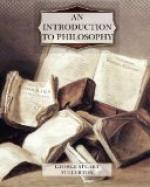With Berkeley’s view of the world as a constant revelation of God, many men will sympathize who have little liking for his idealism as idealism. They may criticise in detail his arguments to prove the nonexistence of a genuinely external world, but they will be ready to admit that his doctrine is an inspiring one in the view that it takes of the world and of man.
With this I wish to contrast the doctrine of another idealist, Mr. Bradley, whose work, “Appearance and Reality,” has been much discussed in the last few years, in order that the reader may see how widely different forms of idealism may differ from each other, and how absurd it is to praise or blame a man’s philosophy merely on the ground that it is idealistic.
Mr. Bradley holds that those aspects of our experience which we are accustomed to regard as real—qualities of things, the relations between things, the things themselves, space, time, motion, causation, activity, the self—turn out when carefully examined to be self-contradictory and absurd. They are not real; they are unrealities, mere appearances.
But these appearances exist, and, hence, must belong to reality. This reality must be sentient, for “there is no being or fact outside of that which is commonly called psychical existence.”
Now, what is this reality with which appearances—the whole world of things which seem to be given in our experience—are contrasted? Mr. Bradley calls it the Absolute, and indicates that it is what other men recognize as the Deity. How shall we conceive it?
We are told that we are to conceive it as consisting of the contents of finite minds, or “centers of experience,” subjected to “an all-pervasive transfusion with a reblending of all material.” In the Absolute, finite things are “transmuted” and lose “their individual natures.”
What does this mean in plain language? It means that there are many finite minds of a higher and of a lower order, “centers of experience,” and that the contents of these are unreal appearances. There is not a God or Absolute outside of and distinct from these, but rather one that in some sense is their reality. This mass of unrealities transfused and transmuted so that no one of them retains its individual nature is the Absolute. That is to say, time must become indistinguishable from space, space from motion, motion from the self, the self from the qualities of things, etc., before they are fit to become constituents of the Absolute and to be regarded as real.




